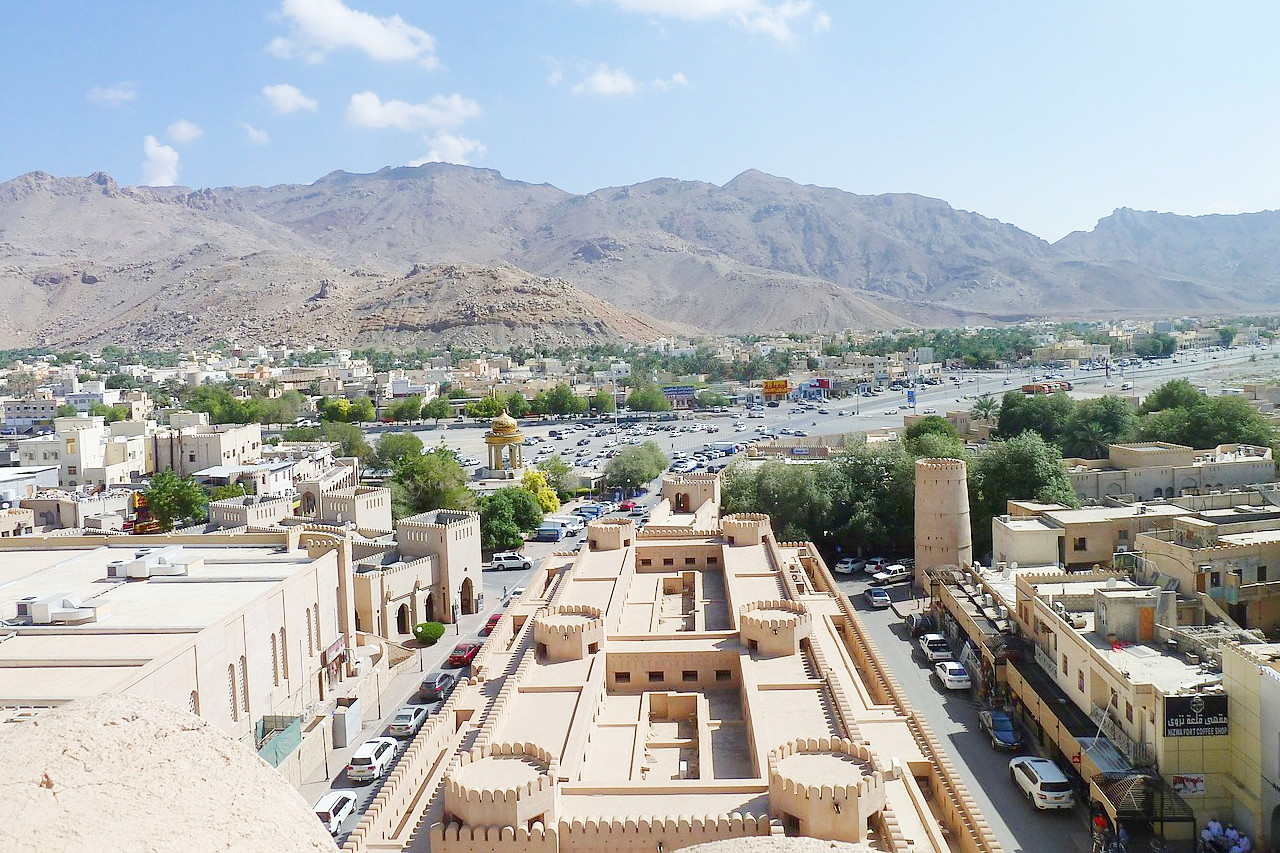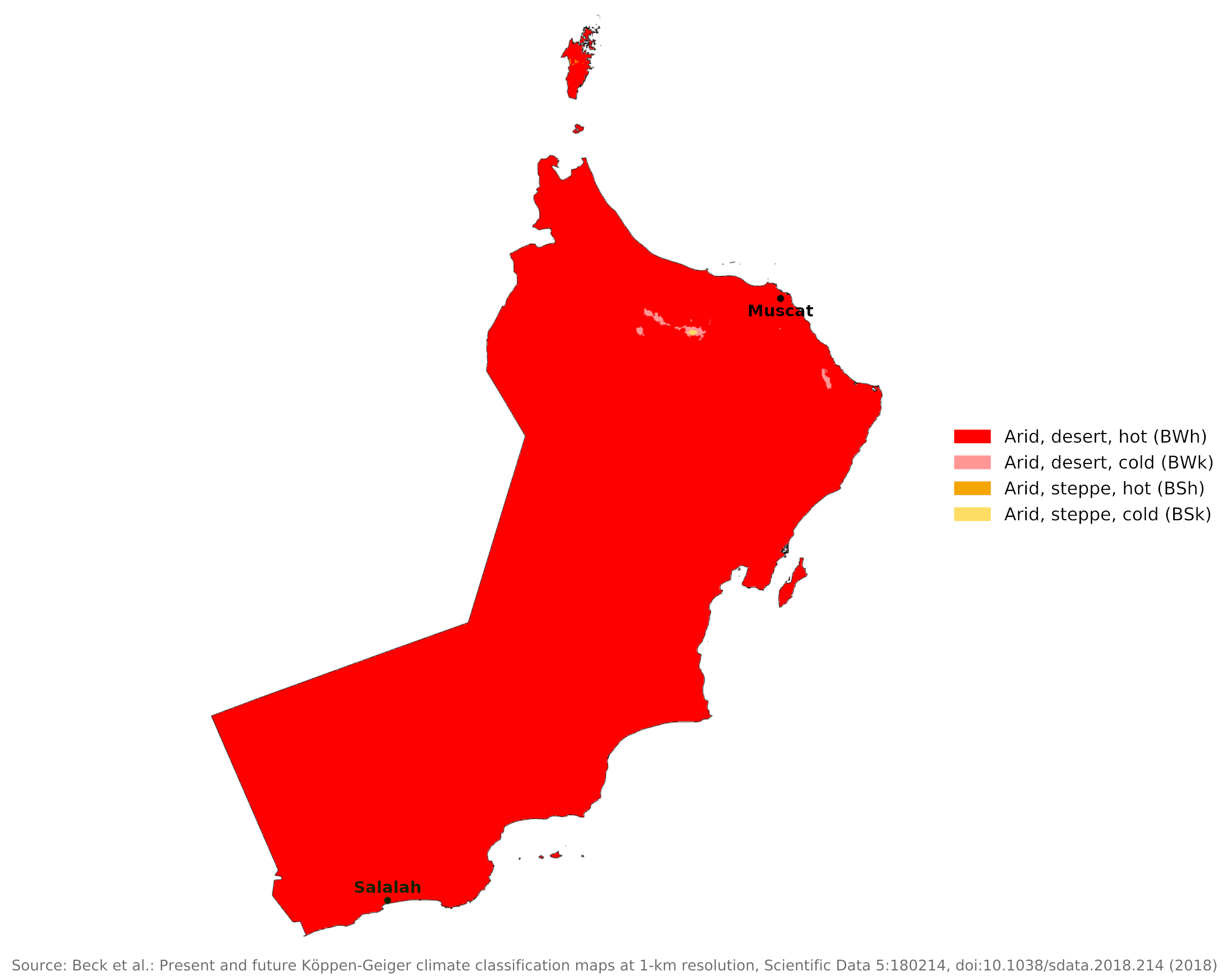The Climate of
Oman
 Nizwa Fort, Ad Dakhiliyah Governorate
Nizwa Fort, Ad Dakhiliyah Governorate
Climate Map
 Climate map of Oman
Climate map of Oman
What is the climate of Oman like?
Oman is located in the extreme southeast of the Arabian Peninsula and is the second largest country in the peninsula. It includes a small enclave at the tip of the Musandam Peninsula, separated from the rest of Oman by the United Arab Emirates. It has coastlines on the Gulf of Oman to the north and the Arabian Sea to the south. Inland, it borders the United Arab Emirates, Saudi Arabia, and Yemen.
With the exception of the Dhofar region, which has a light monsoon climate and receives cool winds from the Indian Ocean, the climate of Oman is extremely hot and dry most of the year. The interior is generally very hot, with temperatures exceeding 40°C (105°F) during the hot season from May to October. The coastal areas are hot and humid from April to October. The prevailing summer wind, the Gharbi (literally, western), makes the heat more oppressive. In the south, the Dhofar (Zufar) region has a more moderate climate.
Summer begins in mid-April and lasts until October. This is the hottest and most uncomfortable time of the year. The mean summer temperature in Muscat is 34°C (94°F), but the Gharbi, which blows from the "Empty Quarter" (the "Rub' al Khali"), can raise temperatures of the towns on the Gulf of Oman by 6°C to 10°C (11–18°F). There is a risk of heat exhaustion during the hottest weather. Sunshine levels are high all year round.
The highest temperatures are registered in the interior, where readings of more than 50°C (122°F) in the shade can occur. Humidity is lower here, which can make the high temperatures more bearable, and the nights can be cooler.
Winter temperatures in Oman are mild and pleasant, ranging between 17°C and 27°C (63–81°F).
The northern part of Oman includes the Jebel Akhdar, a mountain range that rises to just over 3,000 meters (10,000 feet). The annual rainfall on the higher parts of the Jebel Akhdar is likely to reach 500 millimeters (20 inches). The rest of Oman has annual rainfall below 125 millimeters (5 inches) except in the Dhofar hills in the extreme south, which are exposed to the south-west monsoon and receive additional rain in the months of July and August (see Salalah). Dhofar has constantly running streams, which make the region Oman's most fertile area.
Annual rainfall in Muscat averages 100 millimeters (4 inches) and falls primarily between December and April. The wadis (or valleys) of Oman (like the wadis of Arabia generally) are mostly torrential channels, dry for the greater part of the year.
In the far south, the 'rainy' season is between May and September, but it can rain at any time of the year in the Jebel Akhdar. Very rarely, a tropical cyclone in the Arabian Sea brings very wet, windy weather to the coast of Oman, causing wind damage and flooding. A special feature of the Oman weather is that there is regularly thick fog on part of the east coast.
| Climate data for Muscat | |||||||||||||
|---|---|---|---|---|---|---|---|---|---|---|---|---|---|
| Month | Jan | Feb | Mar | Apr | May | Jun | Jul | Aug | Sep | Oct | Nov | Dec | Year |
| Average high °C (°F) | 25.5 (77.9) | 26.1 (79.0) | 29.8 (85.6) | 34.7 (94.5) | 39.5 (103.1) | 40.4 (104.7) | 38.6 (101.5) | 36.2 (97.2) | 36.3 (97.3) | 35.0 (95.0) | 30.5 (86.9) | 27.1 (80.8) | 33.3 (92.0) |
| Daily mean °C (°F) | 21.3 (70.3) | 21.9 (71.4) | 25.2 (77.4) | 29.8 (85.6) | 34.2 (93.6) | 35.2 (95.4) | 34.3 (93.7) | 32.0 (89.6) | 31.4 (88.5) | 29.7 (85.5) | 25.7 (78.3) | 22.6 (72.7) | 28.6 (83.5) |
| Average low °C (°F) | 17.3 (63.1) | 17.6 (63.7) | 20.7 (69.3) | 24.7 (76.5) | 29.1 (84.4) | 30.6 (87.1) | 30.4 (86.7) | 28.4 (83.1) | 27.5 (81.5) | 24.9 (76.8) | 20.9 (69.6) | 18.9 (66.0) | 24.3 (75.7) |
| Average precipitation mm (inches) | 12.8 (0.50) | 24.5 (0.96) | 15.9 (0.63) | 17.1 (0.67) | 7.0 (0.28) | 0.9 (0.04) | 0.2 (0.01) | 0.8 (0.03) | 0.0 (0.0) | 1.0 (0.04) | 6.8 (0.27) | 13.3 (0.52) | 100.3 (3.95) |
| Source: NOAA | |||||||||||||
| Climate data for Salalah | |||||||||||||
|---|---|---|---|---|---|---|---|---|---|---|---|---|---|
| Month | Jan | Feb | Mar | Apr | May | Jun | Jul | Aug | Sep | Oct | Nov | Dec | Year |
| Average high °C (°F) | 27.5 (81.5) | 27.9 (82.2) | 29.9 (85.8) | 31.7 (89.1) | 32.4 (90.3) | 31.8 (89.2) | 28.4 (83.1) | 27.3 (81.1) | 29.0 (84.2) | 30.5 (86.9) | 30.8 (87.4) | 28.7 (83.7) | 29.7 (85.4) |
| Daily mean °C (°F) | 22.9 (73.2) | 23.7 (74.7) | 25.5 (77.9) | 27.6 (81.7) | 29.0 (84.2) | 29.0 (84.2) | 26.4 (79.5) | 25.2 (77.4) | 26.3 (79.3) | 26.3 (79.3) | 25.9 (78.6) | 23.9 (75.0) | 26.0 (78.7) |
| Average low °C (°F) | 17.9 (64.2) | 19.2 (66.6) | 21.0 (69.8) | 23.4 (74.1) | 25.6 (78.1) | 26.5 (79.7) | 24.2 (75.6) | 23.1 (73.6) | 23.4 (74.1) | 21.6 (70.9) | 20.4 (68.7) | 18.8 (65.8) | 22.1 (71.8) |
| Average precipitation mm (inches) | 2.2 (0.09) | 7.0 (0.28) | 6.3 (0.25) | 19.8 (0.78) | 17.1 (0.67) | 10.6 (0.42) | 24.6 (0.97) | 24.5 (0.96) | 4.1 (0.16) | 4.1 (0.16) | 9.6 (0.38) | 1.1 (0.04) | 131 (5.16) |
| Source: NOAA | |||||||||||||
References
- E. A. Pearce, Charles Gordon Smith, (1990) The Hutchinson World Weather Guide, John Murray Press. ISBN 1859863426
- Timothy L. Gall, (ed.), (2003), Worldmark Encyclopedia of the Nations, Eleventh Edition, Thomson Gale
- Federal Research Division, Library of Congress, (1994), Persian Gulf states: country studies. Claitor's Pub. Division. ISBN 0844407933
- Hugh Chisholm, (ed.), (1911), Encyclopædia Britannica, Eleventh edition, Cambridge University Press
The Climate of
Oman

In summary:
Oman’s climate is arid subtropical. The climate generally is very hot, with temperatures reaching 40°C (105°F) in the hot season, from May to October.
Annual rainfall in Muscat averages 100 mm (4 in), falling mostly between December and April. While the mountain areas receive more rainfall, some parts of the coast sometimes receive no rain at all within the course of a year.